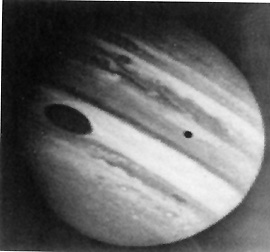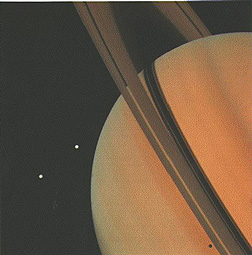The Giant (Outer) Planets¶
Contents
So far we have surveyed the general characteristics of four Rock planets (usually called the Terrestrial Planets because of gross similarities to earth). Now we proceed to look at the Gas planets (normally referred to as the Giant Planets - Jupiter, Saturn, Uranus, and Neptune - because all four are (except for the fifth, Pluto, a maverick) very much larger than the inner rock ones. All of these gas balls are made up principally of hydrogen, some helium, and other gases arranged as thick “mantles” with small central cores of rock with possibly some metal. All have distinct atmospheres with circulation driven in part by planet rotation. The internal temperatures are far too small to favor nuclear reactions, so these planets are in no danger of converting to stars. The general characteristics of the Giant Planets are given on this page. The history of their exploration, by the Pioneer and Voyager spacecraft, and for Jupiter more recently Galileo, is outlined. There is a brief preview of a special feature of each - the presence of both spherical and irregularly shaped satellites made up of rock and ice, and for several sulphur- or organics-rich surfaces.
The Giant (Outer) Planets
Overview of the Outer Planets
Our attention turns now the the four Giant outer planets (plus Pluto, possibly not a legitimate ninth planet) that consist of huge amounts of hydrogen and helium gas surrounding small rock and possibly metal cores. Here is a composite showing a full disc space image of each planet, shown in their relative sizes.
It also helps to place these four and Pluto in their orbits at their relative distances from the Sun, as shown here (the innermost brownish-orange ring is the Earth’s position).
Pioneer 11 passed Jupiter in December 1974, enroute to a flyby of Saturn in September of 1979. This spacecraft traversed Saturn’s rings without being destroyed (as some predicted) by their widely-spaced particles. Pioneer 11 also found evidence that Jupiter’s magnetosphere extends beyond Saturn’s orbit in the direction away from the Sun.
We come now to what is indisputably the most outstanding planetary space missions ever sent forth by mankind: the Voyager 1 and 2 probes to the outer planets. At a cost of under one billion dollars - a true bargain even then; two remarkable spacecraft visited all of the giant planets, Jupiter, Saturn, Uranus, and Neptune. They started their grand tours in 1977 and are still going strong, as these vehicles leave the solar system. They imaged all four planets and 48 satellites, some of which they discovered. A general summary of the Voyager missions is offered on the Jet Propulsion Lab’s (JPL) (Voyager Home Page), and its links.
One impetus for the missions was the favorable alignment of the giant planets that occurs once every 175 years, such that initial trajectories plus corrections might allow at least one spacecraft to fly past Jupiter, all the way to Neptune. With each planetary flyby, the spacecraft received a gravitational “kick” to speed them along, so as to favorably alter their courses and shorten their travel time significantly (without this boost, the trip to Neptune, using the initial launch velocities, would have taken 30 years).
Voyager 2 launched from Earth on August 20, 1977, and arrived at Jupiter on July 9, 1979. Voyager 1 took off on September 5, 1977, reaching Jupiter on March 5, 1979. Even though leaving later, Voyager 1’s shorter path reduced its trip time. Both spacecraft then went by Saturn, Voyager 1 during November 1980 and Voyager 2 in August, 1981, receiving another gravity boost. At their Saturn encounters, the Voyagers had met the initial requirement of five years of operation, but Voyager 1’s chosen trajectory (past Saturn’s moon, Titan) did not favor it continuing to Uranus. So JPL officials allowed it to depart upward (towards celestial north) out of the ecliptic plane. Voyager 2’s “all systems go” status qualified it, with appropriate course corrections, to head to Uranus, encountering it on January 24, 1986. Further course adjustments sent it on to Neptune, with closest approach on August 25, 1989. At each new rendezvous, the spacecraft performed superbly, providing detailed data on each giant planet. Both spacecraft have now left the planetary region of the solar system.
This sketch indicates the trajectories each Voyager followed:
The Voyagers carried instruments designed to support 10 experiments. In addition to TV cameras, others included UV and IR sensors, and cosmic-ray, plasma and charged particle detectors, and magnetometers. These are shown in this schematic diagram:
Because of their extreme distance from the Sun, they could not use solar panels for power, but, instead, they use radioisotope thermoelectric generators (RTGs) that convert heat from decaying plutonium into electricity. Because of this wise power choice, both spacecraft, even today, beam radio signals full of new science data from well beyond 100 A.U. (1 A.U. is the distance from the Sun to Earth: 150 million kilometers [93,000,000 miles]), having passed the heliopause, the outermost boundary of measurable solar wind.
` <>`__19-52: What are the three dots (glitches?) in the Saturn picture? `ANSWER <Sect19_answers.html#19-52>`__
The giant planets are just that: vastly larger, near-spherical bodies, dominated by atmospheres that comprise the bulk of their volumes. Orbiting at 5.2 A.U., Jupiter is the largest, with an equatorial diameter of 142,984 km (88,850 mi, measured from the center to an outer level, where we estimate the atmospheric pressure is 1.0 atm.) and a mass of 1.9 x 1027 kg (4.19 x 1027 lbs) (greater than twice that of all other planets combined, and 318 times greater than Earth’s). Moving further from the sun, the planets are progressively smaller, as follows: Saturn (9.54 A.U.) - 120,530 km (74,897 mi); Uranus (19.22 A.U.) - 51,116 km (31,763 mi); Neptune (30.1 A.U.) - 49,528 km (30,777 mi). They experience polar flattening of about 2% to 10%. Each planet rotates very rapidly for its size. They all have rotational periods less than one Earth day.
The Giant planets consist mainly of hydrogen and helium (for Jupiter and Saturn, the ratio of H/He is about 9:1 by number of atoms and 4:1 by atomic weight); minor amounts of methane and ammonia; and traces of nitrogen and water. Jupiter and Saturn are massive enough to convert the inner layers of hydrogen into a metallic liquid state. For Jupiter, this region is about 40,000 km (24,856 mi) thick. It is less than 15,000 km (9,321 mi) thick for Saturn. For both planets, the region grades outward into liquid molecular hydrogen (Jupiter’s outer region is about 18,000 km [11,185 mi] thick), and then comparatively thin atmospheres. Metallic hydrogen is absent in Uranus and Neptune, so, their interiors are mostly molecular hydrogen. Based on density calculations, all four planets may have a rocky (silicate) core, subjected to high pressures and temperatures (Jupiter: about 20,000° K). The radius of Jupiter’s core is about 5% and Saturn’s about 10% of the planetary radius. The cores of Uranus and Neptune extend to about 1/2 their planetary radius.
Thermal energy released from compression is largely responsible for the internal heat that makes each planet warmer at the surface (reverse thermal gradient) than expected from solar heating alone. For Jupiter, heat from the interior provides 70% more thermal energy than received from the Sun. This energy provides the fluid dynamics that drive the atmospheres into intense motions in belts or zones, roughly parallel to their equators, with wind speeds far in excess of those on Earth. Thermal conditions at great depth cause electron stripping and other mechanisms involving conductive motions that produce magnetic fields around each planet. The fields of Jupiter and Saturn are about 4,000 and 1,000 times, respectively, that of Earth’s magnetic field. The fields of Uranus and Neptune are much weaker. However, the magnetospheres of Uranus and Neptune have unusual shapes and distributions, with the magnetic pole axis of each strongly inclined to the rotational axis. Uranus’s spin axis tilts 98° , so it almost lies in the solar ecliptic plane.
Prior to the Voyagers’ visits, we only knew Saturn had rings of material moving in near-circular paths at varying distances beyond the planet’s (gas-pressure-defined) surface. But, as the spacecraft imaged the three other planets, we found positive visual evidence of generally more subdued rings at each one, so that we now consider rings the norm for this type of gaseous body. The rings consist of minute particles of ice and rock. At Saturn, some are as large as a small house, and concentrate in orbits only a few kilometers thick. Within the rings, the particles are widely separated. The origin of such rings is still uncertain, but opinion favors disruption of earlier satellites. However the rings may have collected debris that eroded from existing satellites, or that the planet captured from interplanetary space, or from “leftovers” during the planetary accretion.
The satellites of the giant planets fall into two principal types: larger ones that adopt spherical shapes, when their constituent materials are sufficiently liquefied to bring about gravitational equilibrium, resulting in an equipotential surface. Smaller ones retain irregular shapes, which suggests that melting has not significantly altered them, or that they are fragments from collisions that broke their parent body(s) apart. The planets may have captured some from asteroid-like belts or from passing comets and other space debris. Most of the satellites consist of mixtures of rock and ice (water, carbon dioxide, or other frozen gases). Ice is often the dominant material at the surface. The surfaces of many satellites show varying, often heavy, cratering that may be preserved states from soon after they formed. Some satellites have unusual, patchwork-like multityped terrains that suggest they were reassembled from pieces torn apart from a collision. Indications of later, partial melting are present in a few. One satellite has an atmosphere; several may contain liquids at or below their surfaces; and at least one has ongoing volcanic activity. All in all, the satellites have a lot in common, yet each retains its own distinctive “character”.
Primary Author: Nicholas M. Short, Sr. email: nmshort@nationi.net








